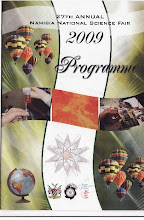
Well, you all know how I feel about driving here since it was the topic of one of my first blog entries. It’s not just the fact that driving is done on the “wrong” side here that makes it difficult to adjust to; it’s all the various and sundry other crazy things that occur as well that contribute to my being a nervous wreck behind the wheel.
First anything goes here. Like the photo above demonstrates, four-wheelers are allowed to be driven on city streets. As you can see from the picture, they’re even licensed! We’ve seen dune buggies, three-wheelers, elderly chair scooters, etc. If it’s got wheels and a motor, we’ve probably seen it on the streets of Windhoek.
Additionally, there seems to be a high tolerance for risk taking behavior here. Safety appears to be a non-issue for Namibians. Parents think nothing of driving with kids in their lap, in the front seat unrestrained or packed to the gills in an open-bed bakkie (pick-up truck). I cringe every time I come up behind one of these vehicles because I can envision a kid falling out right in front of my on-coming vehicle and me running over him/her with my kids in the car.
Taxi drivers are the absolute worst, however. They will make two lanes where there was only one originally. They’ll turn right in front of you even if you’ve got the right of way. They typically jump the light before it turns green and run the red ones. They’ll pass you in town, in neighborhoods or any time they feel like it even if the road signs indicate against such. An acquaintance from school is currently driving around with a huge dent in her driver’s side door where she “was kissed” by a taxi! Because there are zillions of taxis, they can't be avoided either.
Perhaps it’s the German influence, but excessive speed is a major factor in road accidents here in Namibia, so many of which end in a fatality. Drivers treat these little two lane shoulder-less roads as if it were the Autobahn. Posted speed for the “highway” is 120 km. That’s 75 miles per hour on a road that’s not even close to being in interstate condition. Mind you, that’s the posted speed; people are typically flying by us and so we figure they’re up to 150 or 160 Km. Encountering a wart hog or an oryx at that speed would spell sheer disaster, but it’s as if most drivers don’t even give it a second thought.
She may be slow and lumbering, but she’s built solid like a rock. With her bull bar in the front, Ole Bess can out intimidate most other vehicles, so we’re hoping that we can stay safe and sound for the remainder of our 3 month stay here in Namibia. We’ll be sad to part with her when the time comes. She’s been such a good girl.





